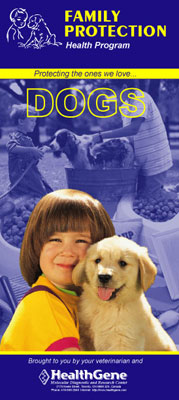Health Program for Dogs
FAMILY PROTECTION Health Program for dogs contains the most common zoonotic infections:

Leptospira spp
Cryptosporidium spp.
Giardia spp.
Ringworm
Toxocara canis
HealthGene recommends submitting urine, hair (or skin scrapes) and fecal samples for the FAMILY PROTECTION Health Program.
For more information, contact your veterinarian
LEPTOSPIRA SPP
Description:
Leptospirosis is a bacterial disease that affects many species of animals as well as human beings. Dogs become infected with Leptospira through contact with the urine of infected animals. Stagnant water, contaminated with urine is a common source of infection as are rats. Transmission is greatest during periods of wet weather. Leptospira gains entrance to the bloodstream through mucous membranes or wounds. Once in the blood stream, the organism spreads rapidly to body organs that include the liver, spleen and kidneys. When Leptospira reaches the kidneys, the dog starts shedding the bacteria in the urine. This can continue for weeks or months.
Humans become infected the same way as animals, through contact with materials that have been contaminated with urine from infected animals.
Clinical Signs In Humans:
Human infections with Leptospira begin, after an incubation period of 7-12 days, with fever (biphasic) and “flu-like” illness. Patients may then develop intense headaches, severe myalgia, abdominal pain, nausea, diarrhea, and sometimes rash, conjunctivitis and conjunctival hemorrhage.
Clinical Signs In Dogs:
The first signs of leptospirosis are fever and depression. Dogs appear to ache and be tender all over. Infection of the kidney leads to blood-tinged reddish urine. Other symptoms include oral ulcers and uremia.
CHRYPTOSPORIDIUM SPP
Description:
Cryptosporidiosis is a diarrheal disease caused by microscopic parasites of the genus Cryptosporidium. Once an animal or person is infected, the parasite lives in the intestine and passes in the stool. The parasite is protected by an outer shell that allows it to survive outside the body for long periods of time.
Clinical Signs In Humans:
The most common symptom of cryptosporidiosis is watery diarrhea. Other symptoms include dehydration, weight loss, stomach cramps or pain, fever, nausea and vomiting. Symptoms of cryptosporidiosis generally begin 2 to 10 days (average 7 days) after becoming infected with the parasite.
Clinical Signs In Dogs:
In dogs, infections appear to be mostly subclinical but may induce diarrhea.
RINGWORM
Description:
Ringworm is not caused by a worm as the name would suggest but rather is a skin infection caused by a group of fungi. Infected dogs most often come from environments housing large numbers of animals. The most common areas for ringworm to occur are the face, ear tips, tail and paws. Ringworm is transmitted by contact with an infected animal’s skin or fur, either directly or from a contaminated environment. Adult humans are usually resistant to infection unless there is a break in the skin but children are quite susceptible. Transmission can also occur from an infected environment. The fungal spores may live in bedding and carpet for several months.
Clinical Signs In Humans:
In humans, ringworm often appears as a round, red, itchy lesion with a ring of scale around the edge.
Clinical Signs In Dogs:
In dogs, signs of ringworm are typically circular patches of broken hair in ring-like whorls. These areas usually heal at their centers, growing darker than normal hair. Surrounding this darkened area is a band of inflamed, reddened skin within which the hair is also broken off short. More about ringworm infection.
TOXOCARA CANIS
Description:
Toxocariasis is caused by a nematode Toxocara canis which is a roundworm that can grow up to 18 cm in length. T. canis infections are extremely common in puppies less than 3 months of age and can also occur in older dogs. Many dogs have the worm present in the small intestine. Infected dogs periodically pass the egg stage of the worm in their feces, and so contaminate the environment and act as a source of infection for spread to other animals and humans. Studies have shown that 2-3% of adults and 7-14% of schoolchildren have been exposed to T. canis.
Clinical Signs In Humans:
T. canis infection can cause an eye disease with inflamation and formation of a scar on the retina that may lead to permanent partial loss of vision. In more severe cases, the infection causes swelling of the body’s organs or central nervous system accompanied by fever, coughing, asthma, or pneumonia.
Clinical Signs In Dogs:
The vast majority of dogs infected with T. canis show no signs of disease. Young puppies are more likely to show clinical signs, and these will be worse if the puppy has a large number of worms. Signs include noisy breathing, coughing, nasal discharges, vomiting, diarrhea, stunted growth rate, distended abdomen, and pale mucous membranes. Sometimes infected puppies have abdominal discomfort, grown when touched or lifted and are reluctant to move.




